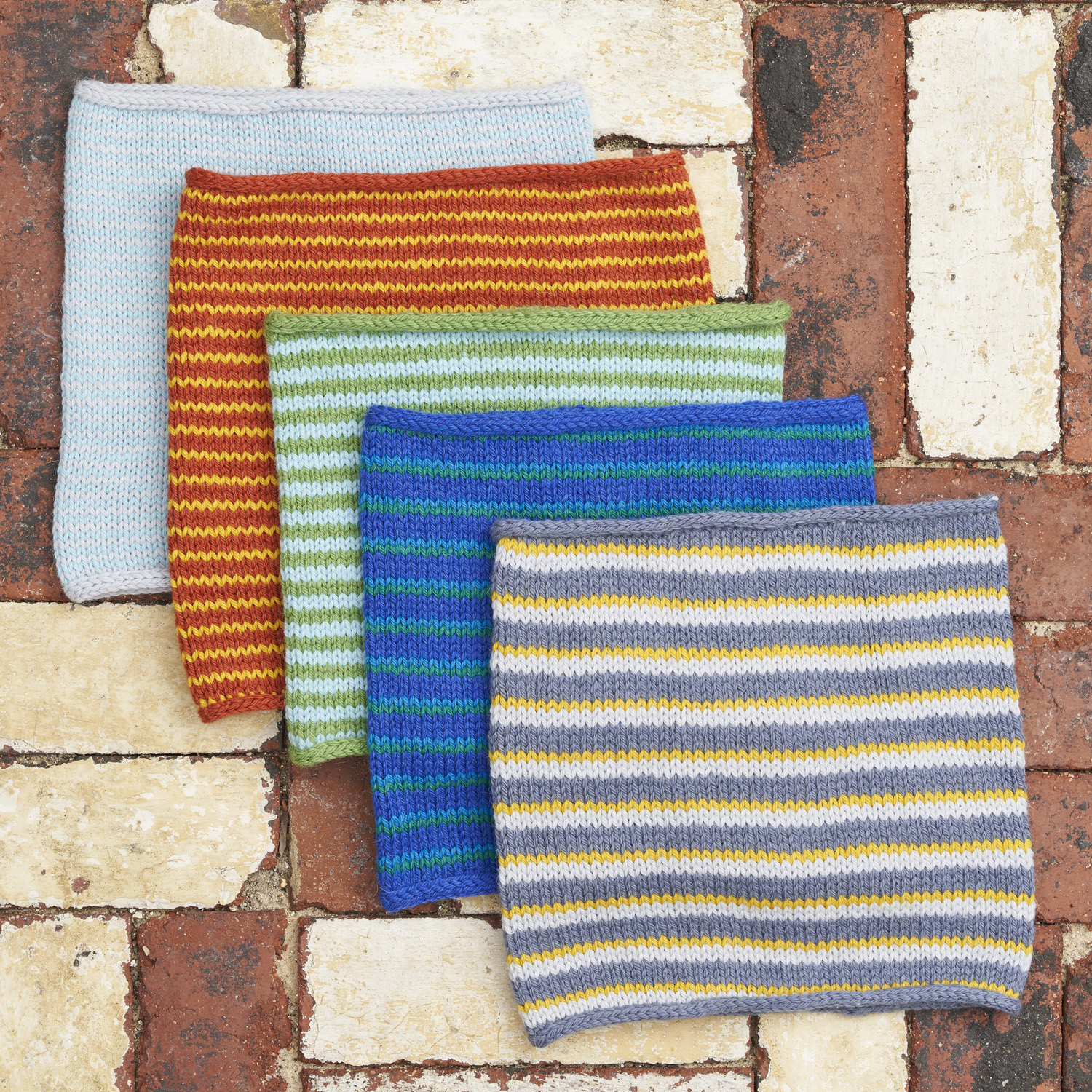Now that you’ve got two-round stripes and stitch patterns nailed, you’re ready to open the doors to a whole new world of helical possibilities…
Read moreAndrade cowl
As I mentioned yesterday, one of the ways in which helical stripes differ from traditional stripes is that they make the fabric slant. The more rounds you have in your stripe pattern, and the smaller the circumference of your knitting, the more the stripes appear to slant in the fabric. I absolutely love the effect this gives when you push it as far as you can, and I struggle to see how else you would achieve this look in your knitting.
Read moreTwiss cowls
Lots of knitters have asked me about how to work multiple round stripe patterns helically. In fact, this question is one of the things that motivated me most in writing the Something New to Learn About Helical Knitting ebook. The Twiss cowls are really my answer to the question of how to work stripes with more than 1 round in each colour. The pattern includes details on how to work 3-, 4-, 5-, and 6-round stripe repeats, including patterns where you work more than one round in each colour.
Read moreMomo hat
Clearly I’m not yet done with helical designs! If you’ve already purchased Something New to Learn About Helical Knitting, this bonus design will be added to your Ravelry library later today, but this is also available as a single pattern download. Giuseppe Momo is the name of the architect who designed the newer 1932 double helix staircase at the Vatican Museum in Rome (below). This is one of the most spectacular double helix staircases, and so it seems a fitting name for a hat that features both helical garter stitch, and a cable panel that has a bit of a helical look to it!
Read moreWorking helically
I’m sitting at my desk, surrounded by helical knitting swatches and samples. In case it wasn’t already obvious, I’m rather in love with this unusual technique! As I’ve published helical designs, there are a few questions that have popped up regularly, and one of the most common themes is around working other instructions at the same time as working helically.
Read moreVideo: i-Cord cast-off method
I-cord cast off gives a smooth, rounded edge to your knitting. Find out how to do it from this straightforward video tutorial.
Read moreVideos: Basic 1x1 helical stripes
These two videos cover the basics of working jogless helical stripes, whether you use circular needle, or double-pointed needles.
Read moreHelical stitch patterns and a pair of cowls
It has been brilliant to see a number of people in the helical knitalong saying how magical they are finding 1x1 helical stripes. It’s this sense of wondrous ease, and yet cleverness that has driven the development of the stitch patterns in today’s new chapter of Something New to Learn About Helical Knitting. I had already dipped my toe in the water of helical stitch patterns with my Spiralling Socks designs. They use the combination of a knit round and a slipped stitch pattern to create a pleasing helical effect, and I was quite sure that there must be plenty of other patterns that would be fun to work in this way.
Read moreOn the naming of patterns – part 2
Double helix staircase at the Chemistry department of the University of Reading. Image © Jen Arnall-Culliford
I had the pleasure of a trip to visit Felicity (Felix) Ford at Knitsonik HQ a couple of weeks back. We are making mischievous plans for next year, and after lunch we decided to go for a walk before I headed back to Frome. By complete happenstance, Felix’s route took us through the campus of the University of Reading, so we made an abrupt change of plans and went to visit the Chemistry and Pharmacy department, which is home to a double helix staircase. Read more to find out about the double and triple helix staircases that provided the names for the patterns in Something New to Learn About Helical Knitting.
Read moreBasic Helical Stripes and the Bramante Cowl
Today we are releasing the first chapter in Something New to Learn About Helical Knitting.
Chapter 1 starts at the very beginning. Of course!
If you have never worked helically before, this is the chapter for you. If you’re already a helical fan, then don’t worry, there are plenty of new explorations for you in the later chapters. The first chapter is the knitting equivalent of the first term at a new school or university, where we make sure that everyone is up to speed on the foundations, before diving into the wider subject.
Read more




